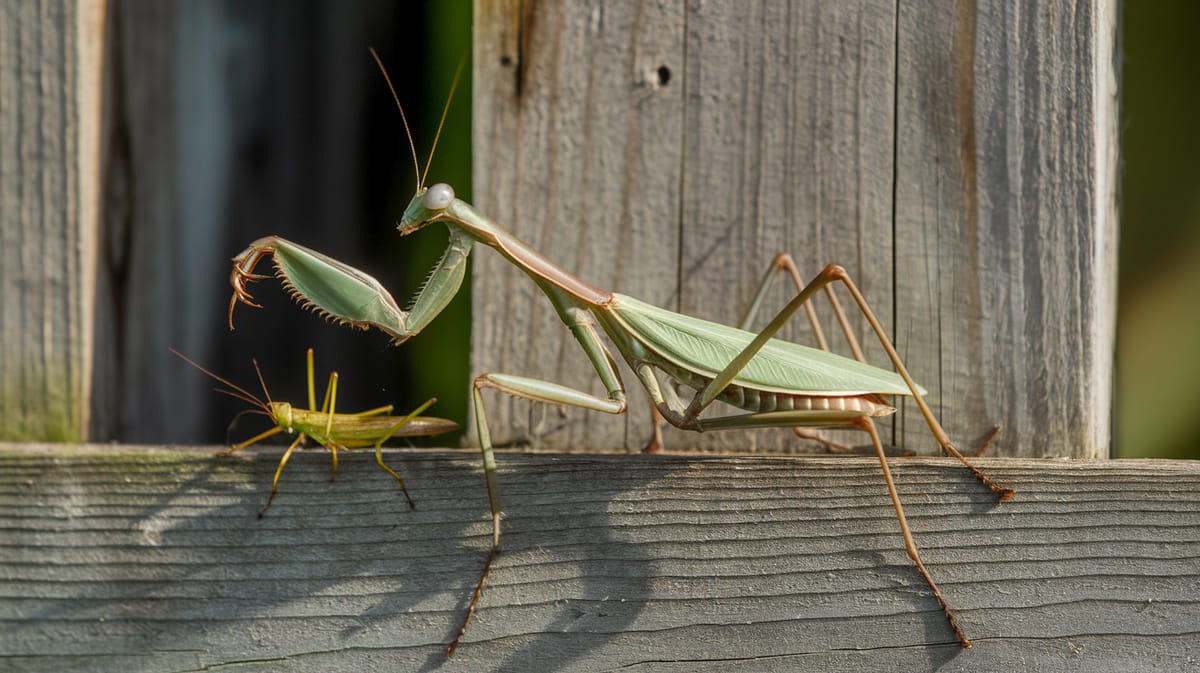Praying Mantis
Patient predator with an iconic posture, the Praying Mantis strikes with speed and precision. This insect plays a vital role in controlling pest populations.

Key Insights at a Glance
Did You Know?
Taxonomy & Classification
Praying mantises are formidable insect predators, equipped with raptorial forelegs and binocular vision, showcasing their evolutionary prowess in ambush hunting across diverse environments. Let's understand the evolutionary journey and classification of these remarkable predators.
Species Diversity
Over 2,400 species of praying mantises are classified under 430 genera, exhibiting a wide array of adaptations across different ecosystems.
Ancient Origins
Dating back 146 million years to the Cretaceous period, mantises have persisted through significant extinction events, highlighting their adaptability.
Lifecycle and Growth
A remarkable journey of transformation from Egg to Adult.
Egg
A female mantis lays eggs in a frothy ootheca, which hardens to protect the developing embryos from predators and harsh conditions.
Nymph
Nymphs emerge as wingless replicas of adults, shedding their exoskeletons multiple times to grow and develop adult features.
Adult
Adults possess wings and refined predatory skills, focusing on hunting, mating, and laying eggs to ensure species survival.
Dietary Habits
A masterful predator with exceptional hunting skills, this insect adjusts its diet to include diverse insects and small vertebrates.
| DIET TYPE | DESCRIPTION |
|---|---|
| Primary Diet | Primarily consumes grasshoppers, beetles, and flies, using swift forelegs to seize prey efficiently. |
| Secondary Diet | Occasionally targets small reptiles and amphibians, such as frogs or lizards, when available in its environment. |
| Occasional | Rarely catches birds or rodents, exhibiting opportunistic feeding during unique or scarce conditions. |

Behaviour and Adaptations
Discover the fascinating capabilities that make the Praying Mantis a standout predator in the insect world.
Ambush Mastery
Patiently waits motionless for prey, then strikes with precision.
Camouflage
Blends into foliage, resembling leaves and twigs to avoid detection.
Rotational Vision
Can rotate its head 180 degrees to spot prey and predators.
Ecosystem Impact
Praying Mantises play a crucial role in sustaining ecological balance.
Natural Pest Control
Praying Mantises help regulate pest populations by feeding on various insects.
Biodiversity Support
They contribute to biodiversity by serving as prey for birds and small mammals.
Garden Health Boosters
By controlling pest insects, they promote healthier plant growth in gardens and farms.
Conservation Challenges
Understanding and addressing the major threats to Praying Mantis populations.
Habitat Destruction
Urbanization and agriculture reduce natural habitats for mantises.
Pesticide Use
Chemical pesticides disrupt mantis survival and reproductive cycles.
Climate Change
Changing weather patterns alter mantis habitats and food availability.
Frequently Asked Questions
How long do Praying Mantis live?
Praying mantis typically live for about 6 to 12 months. Their lifespan can vary depending on the species and environmental conditions. Most mantises spend the majority of their life as nymphs, with the adult stage lasting a few months.
What do Praying Mantis eat?
Praying mantis are carnivorous and primarily eat insects such as flies, mosquitoes, crickets, and grasshoppers. Larger mantises may prey on small vertebrates like lizards, frogs, and even birds. They are known for their predatory skills and patience.
Are Praying Mantis poisonous?
Praying mantis are not poisonous to humans. They do not have venom or any toxic components. While they are effective predators of insects, they pose no harm to humans, making them safe to handle.
Are Praying Mantis endangered?
Praying mantis are not considered endangered. They are widespread and adaptable to various habitats. Some species may face local threats due to habitat loss, but overall, mantises are not at risk globally.
What do Praying Mantis symbolize?
Praying mantis often symbolize patience, calmness, and mindfulness. In various cultures, they are seen as a sign of good luck or spiritual insight, representing a connection with nature and the importance of stillness and contemplation.
Do Praying Mantis bite?
Praying mantis can bite if they feel threatened, but bites are rare and not harmful to humans. They have small mouths and are more likely to flee than to bite when disturbed.
What color are Praying Mantis?
Praying mantis can be green, brown, or a mix of both. Their coloration helps them camouflage in their environment, blending in with leaves and branches to avoid predators and ambush prey.
Does a Praying Mantis have wings?
Adult praying mantis usually have wings, although some species may be wingless. Males often have fully developed wings and can fly, while females may have shorter wings and are generally less capable of sustained flight.
What does a Praying Mantis look like?
Praying mantis have elongated bodies, triangular heads with bulging eyes, and long, bent front legs used for catching prey. They have a distinctive posture, resembling a person in prayer, which aids in camouflage and hunting.
Is a Praying Mantis an insect?
Yes, a praying mantis is an insect. It belongs to the order Mantodea. As insects, they have three main body parts: head, thorax, and abdomen, along with six legs and two antennae.
Related Insects
Discover insects with similar characteristics to Praying Mantis - including shared habitats, diets, and taxonomic classifications
Share this profile
Help others discover Praying Mantis
